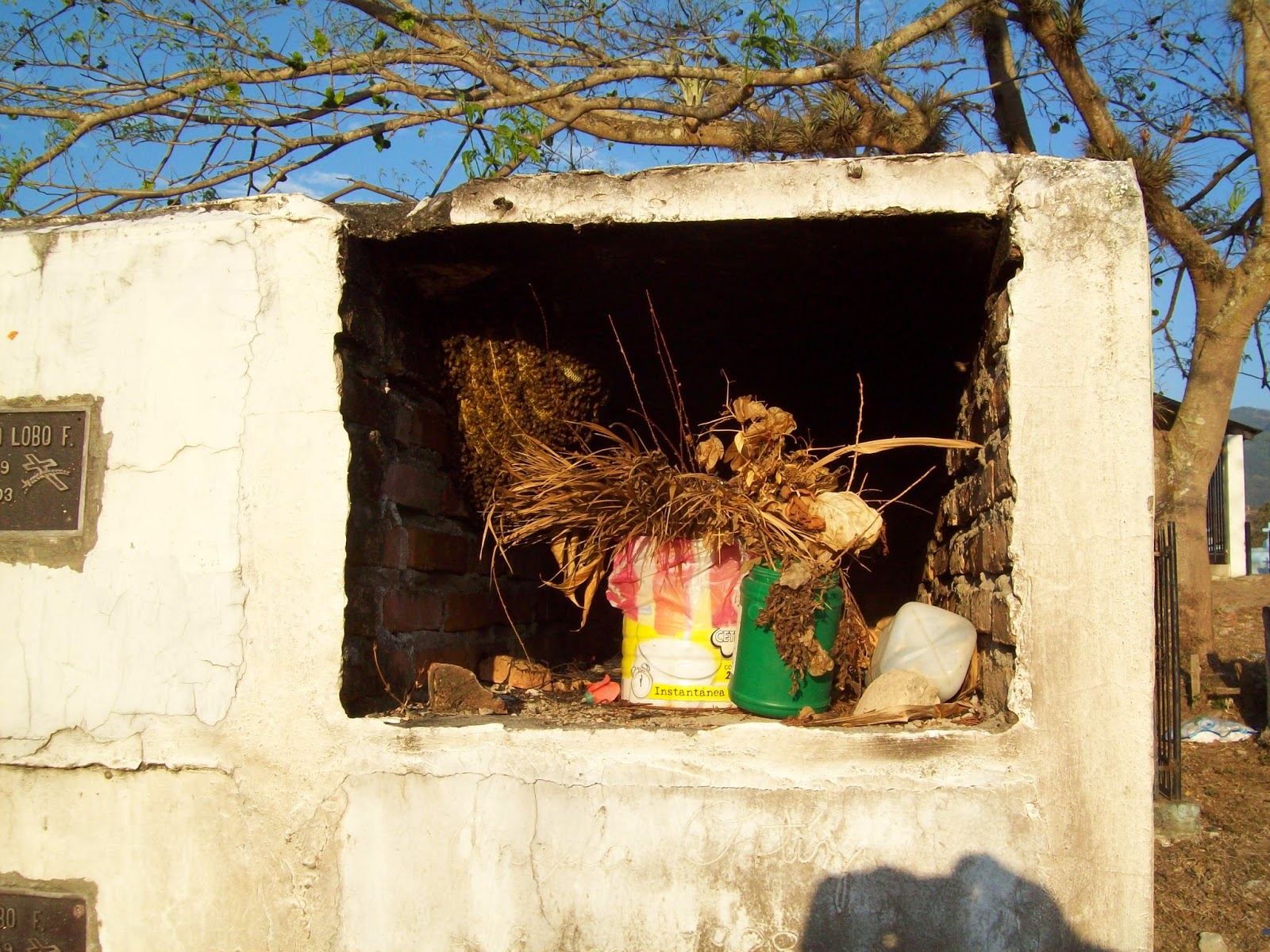Bees in Honduras often set up their colonies in
unusual places, including in graves. This is the continuation of the previous blog entry where I told my tale about having to deal with such a
colony on the morning of someone’s burial. I thought we had taken care of the problem
but things turned out to be otherwise.
About seven or eight weeks later I happened to run
into one of the family members in the street. She said that there were still
bees in the mausoleum. She wanted me to go take a look at it.
“What?,” I thought, a bit confused about the whole
thing. “Was there another crack where the colony could exit from? Did the bees
somehow make another entrance?”
I went down to the cemetery to investigate. There were
bees there alright, but it wasn’t the same hive. A swarm had arrived and they
had decided to move into the last empty grave at the top part of the mausoleum.
The colony of bees, hiding behind the dried flowers
The combs were fairly large so they had been there
maybe two or three weeks. The odd part was that it was basically an open air
colony. The entrance was about three feet by three feet and they were located
close to the front edge of it. Although Africanized bees are not particularly
fussy about where they set up a new colony, you don’t usually see them so much
in the open like this.
“Okay,” I thought after studying them for a while. “It
should be a fairly simple process to remove it and get them into a box.”
I went home and got some comb saver frames ready for a
top bar nuc box I had on hand that would be plenty big enough for these girls.
These frames are made to fit inside of my trapezoidal top bar hives. It makes
dealing with the comb from cut outs easy. As combs are removed they are set
into and then wired into the frames.
My wife Sofia also agreed to come along and give me a
hand—as long as we would be out of the cemetery before dark. She’s not the type
who cares to be among tombs after night falls.
I planned to do the removal in the late afternoon. If
the bees would get ornery it would get dark real fast so they could settle
down. Safety is always a concern when doing cut outs of an Africanized colony. I
don’t worry about myself but for people who might be wandering by when they
shouldn’t. In this case the nearest house was probably at least 75 yards away,
giving me a pretty good buffer zone.
This removal was actually fast and easy (usually they
aren’t). The colony was basically right in front of my face. Access was no
problem. The frames worked like a charm for the combs that I removed. They are
perfect for new combs such as these that are fragile to begin with. Add in the extra
weight from the amount of brood they had and it compounds the care that needs
to be taken.
I’ve never had a colony in a more convenient situation
for its removal as this one. It was all right there in front of me. No
stooping, no climbing, no chopping, no prying. All I needed to do was cut off
the comb, check it for the queen and then tie it into one of the comb saver
frames.
Just about done with the cutout-- only a couple more
combs left. Each comb was put into a frame with wire zigzagging back and forth
to hold it in. The wire wrapped around several small shoe tacks.
The only problem was that I didn’t find the queen. I
was looking but couldn’t locate her. There was one, however, since the combs
were full of nice brood which included eggs. I could only hope that she had
somehow gotten into the box, which I left in the grave so all the stragglers
could crawl into it.
The stragglers needed to crawl into the box with the
rest of the bees.
I think it was probably two evenings later when I went
to the cemetery to collect the colony and take it to one of my apiaries. This was
at night, so no, my wife did not tag along with me.
I didn’t actually look inside at the hive until about
two weeks later. I always make sure the bees have time to settle into their new
home before disturbing them again. What a nice surprise I had.
Most of the empty spaces inside of the frames had been
drawn out. All the combs were full of nicely capped brood. They had their queen
because I again saw some recently laid eggs. I still didn’t see her though. She
was pretty good at playing hide and seek.
That surprise came later when looking at the photos I
had taken. There she was, right in the center of one of the combs!
There she is, right in the middle of the frame! I
didn’t notice she was there until I looked at this photo later. Her darker
color helped to camouflage her (or maybe I just needed some new glasses).
So does this mean that the story is over? Not quite.
There’s still one more chapter.
---Tom
----------
To
read this blog entry in Spanish, go to my other blog, “Reflexiones Sobre
Apicultura.”












